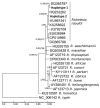High Prevalence and Low Diversity of Rickettsia in Dermacentor reticulatus Ticks, Central Europe
- PMID: 35318933
- PMCID: PMC8962898
- DOI: 10.3201/eid2804.211267
High Prevalence and Low Diversity of Rickettsia in Dermacentor reticulatus Ticks, Central Europe
Abstract
We collected 1,671 Dermacentor reticulatus ticks from 17 locations in the Czech Republic, Slovakia, and Hungary. We found 47.9% overall prevalence of Rickettsia species in ticks over all locations. Sequence analysis confirmed that all tested samples belonged to R. raoultii, the causative agent of tick-borne lymphadenopathy.
Keywords: Czech Republic; DEBONEL; Dermacentor reticulatus ticks; Dermacentor spp.-borne necrosis erythema lymphadenopathy; Hungary; Rickettsia; Rickettsia raoultii; Slovakia; TIBOLA; tick-borne infections; tick-borne lymphadenopathy.
Figures

Similar articles
-
First report of Rickettsia raoultii in field collected Dermacentor reticulatus ticks from Austria.Ticks Tick Borne Dis. 2016 Jul;7(5):720-722. doi: 10.1016/j.ttbdis.2016.02.022. Epub 2016 Mar 2. Ticks Tick Borne Dis. 2016. PMID: 26976704
-
First report of Rickettsia raoultii and Rickettsia helvetica in Dermacentor reticulatus ticks from the Czech Republic.Ticks Tick Borne Dis. 2016 Oct;7(6):1222-1224. doi: 10.1016/j.ttbdis.2016.07.011. Epub 2016 Jul 21. Ticks Tick Borne Dis. 2016. PMID: 27473853
-
Rickettsia slovaca and Rickettsia raoultii in Dermacentor marginatus and Dermacentor reticulatus ticks from Slovak Republic.Exp Appl Acarol. 2012 Jun;57(2):189-97. doi: 10.1007/s10493-012-9539-8. Epub 2012 Mar 6. Exp Appl Acarol. 2012. PMID: 22392435
-
Spotted fever group rickettsiae transmitted by Dermacentor ticks and determinants of their spread in Europe.Ann Agric Environ Med. 2020 Dec 22;27(4):505-511. doi: 10.26444/aaem/120602. Epub 2020 May 7. Ann Agric Environ Med. 2020. PMID: 33356053 Review.
-
Tick-borne rickettsioses in Europe.Ticks Tick Borne Dis. 2012 Dec;3(5-6):271-8. doi: 10.1016/j.ttbdis.2012.10.035. Epub 2012 Nov 21. Ticks Tick Borne Dis. 2012. PMID: 23177355 Review.
Cited by
-
Novel Genetic Lineages of Rickettsia helvetica Associated with Ixodes apronophorus and Ixodes trianguliceps Ticks.Microorganisms. 2023 May 5;11(5):1215. doi: 10.3390/microorganisms11051215. Microorganisms. 2023. PMID: 37317189 Free PMC article.
-
The influence of forest habitat type on Ixodes ricinus infections with Rickettsia spp. in south-western Poland.Curr Res Parasitol Vector Borne Dis. 2024 Jul 8;6:100200. doi: 10.1016/j.crpvbd.2024.100200. eCollection 2024. Curr Res Parasitol Vector Borne Dis. 2024. PMID: 39148674 Free PMC article.
-
Spatial Distribution and Pathogen Profile of Dermacentor reticulatus Ticks in Southeastern Poland: A Genetic and Environmental Analysis.Transbound Emerg Dis. 2024 Apr 24;2024:5458278. doi: 10.1155/2024/5458278. eCollection 2024. Transbound Emerg Dis. 2024. PMID: 40303098 Free PMC article.
-
A New Endemic Locality of Dermacentor reticulatus in Central-Southern Poland and Its Potential Epidemiological Implications.Insects. 2024 Jul 30;15(8):580. doi: 10.3390/insects15080580. Insects. 2024. PMID: 39194785 Free PMC article.
-
Tick-Borne Bacterial Diseases in Europe: Threats to public health.Eur J Clin Microbiol Infect Dis. 2024 Jul;43(7):1261-1295. doi: 10.1007/s10096-024-04836-5. Epub 2024 Apr 27. Eur J Clin Microbiol Infect Dis. 2024. PMID: 38676855 Review.
References
-
- Wölfel R, Essbauer S, Dobler G. Diagnostics of tick-borne rickettsioses in Germany: a modern concept for a neglected disease. Int J Med Microbiol. 2008;298:368–74. 10.1016/j.ijmm.2007.11.009 - DOI
Publication types
MeSH terms
LinkOut - more resources
Full Text Sources
Miscellaneous

